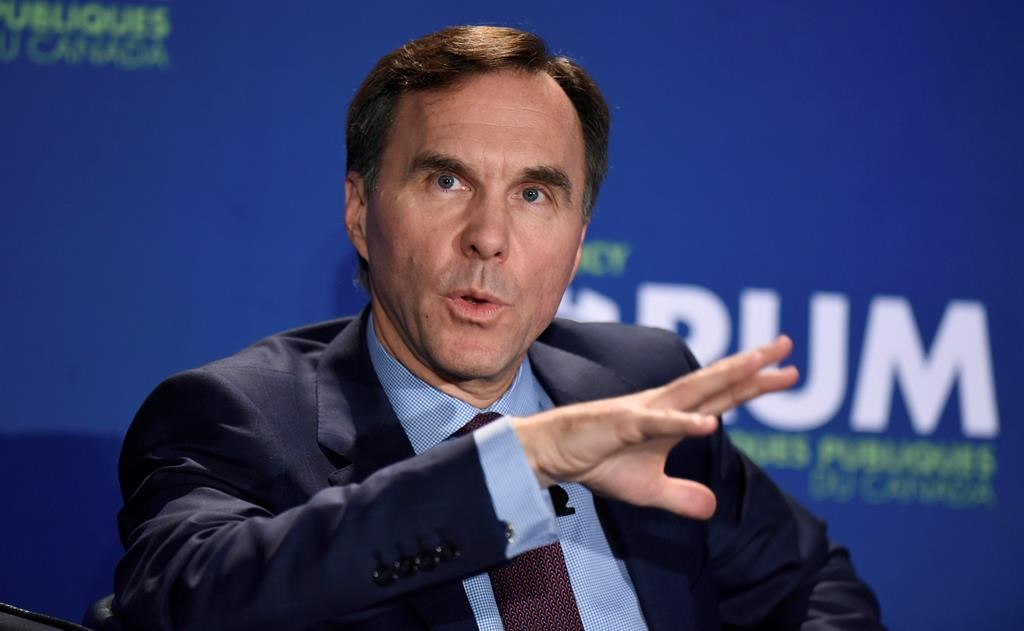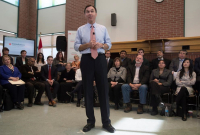Support strong Canadian climate journalism for 2025
The federal government ran a budgetary deficit of $1.5 billion in October as increases in spending on programs outpaced increases in tax revenues.
The Finance Department’s monthly fiscal monitor also says the federal government has a deficit of $9.3 billion since the 2016−17 fiscal year started in April. That figure for the April−to−October period is a swing from the $600 million surplus the Finance Department reported during the same stretch in the 2015−16 fiscal year.
The numbers are not surprising given the Liberals have promised to run deep deficits over the coming years to finance major infrastructure work and more lucrative child benefits to help boost economic growth.
The Finance Department’s updated long−term outlook for the economy suggests that if things hold, the federal debt−to−GDP ratio will decline in the coming years even as Canada’s aging population puts a damper on economic growth as baby boomers leave the workforce.
A spokesman for Finance Minister Bill Morneau said the report shows that Canada’s fiscal situation is sustainable over the long−term and could ultimately improve. Dan Lauzon said the numbers also reinforce the need for the government to make continued investments to help create jobs and economic growth.
"The situation is delicate, and there’s a fine balance. We need to make every dollar count. Whether in transit, in clean technologies, or in health care, we will continue to make the kinds of investments that make a positive difference in the lives of families, and we will do so prudently," he said.
It was the first wave of baby boomers hitting the workforce in the 1960s that boosted the potential growth in the Canadian economy. As they now move into retirement, the government expects their departure to have the opposite effect on the country’s finances as "powerful, slow−moving global forces" dampen economic growth for the foreseeable future, the Finance Department says.
The update says the federal debt−to−GDP ratio will hover around its current levels of about 31 per cent until the early 2030s when it is expected to decline, unless their are changes in expected government spending and growth rates: Higher than expected spending and lower than expected growth would make federal finances unsustainable, while the opposite scenario would see the ratio drop to zero years earlier.
The monthly check on government spending shows federal program expenses were up 8.2 per cent, or $12 billion, between April and October compared to the same period last year, largely a result of jumps in major transfers to people — including child, senior and employment insurance benefits — and spending at departments like National Defence.
Public debt charges were down by about $100 million, or 3.1 per cent, compared to October 2016 because of lower interest rates. The fiscal monitor also shows that revenues rose by 11.3 per cent, or $2.5 billion, compared to the same time last year, with more money coming in from personal income, corporate and excise taxes.
Personal income tax revenue rose by 7.6 per cent, corporate tax revenue rose by 16 per cent and GST revenues rose by $600 million. Employment insurance premium revenues were up as well by $18 million, or 1.5 per cent, from the period last year.





Comments
Whoever at the National Observer selects the headlines should be admonished for using the term "shortfall" when describing the federal "fiscal balance". That is a highly inaccurate but value-laden word which entirely misrepresents how public finances work at the federal level.
As the issuer of currency, the Government of Canada can never run out of money and can fund every single social requirement it faces. It is impossible for there to be a limit on the capacity of a sovereign government to pay debts denominated in its own currency.
For the economy as a whole, in any accounting period, total income must equal total expenditures. The only requirement is, regardless of how many sectors we choose to divide the whole economy into, the sum of the sectoral financial balances must equal zero. For example, if we divide the economy into three sectors - the domestic private (households and firms), government, and foreign sectors - the following identity must hold true:
Domestic Private Sector Financial Balance + Fiscal Balance + Foreign Financial Balance = 0
Note that it is impossible for all three sectors to net save, i.e. run a surplus, at the same time. Some sector has to be issuing liabilities. This is an accounting identity, not a theory. If it is wrong, then five centuries of double entry book keeping must also be wrong.
Those who attack deficit spending are setting up an entirely false constraint. A sovereign government that issues its own currency faces no inherent financial constraints. It cannot produce a financial imbalance. It can buy ANY resources that are for sale in terms of its own currency by using key strokes. That does not mean it should try to buy all the resources, as it can produce inflation in certain circumstances and it can, in theory, leave insufficient resources to fulfill the private purpose.
Government needs to use its sovereign power to move just the right amount of resources to serve the public purpose while leaving enough for the private purpose. However, that balance is entirely POLITICAL, not driven by financial need. There can NEVER be a "shortfall" in loonies.